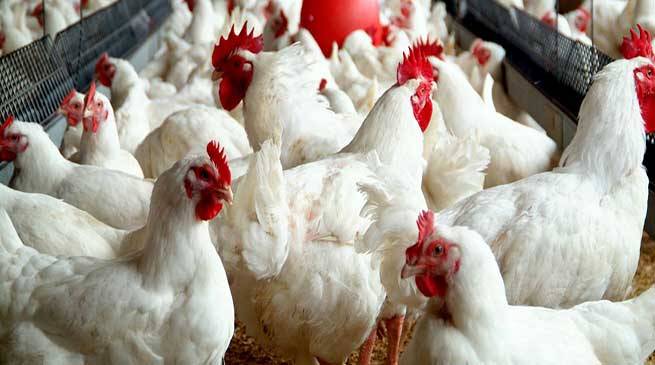
Agriculture has traditionally been one of India's core and most important activities. Agribusiness is currently doing incredibly well, with poultry farming progressively becoming the country's fastest growing and most profitable practice. The Indian chicken sector has evolved dramatically over the last four decades, from age-old household farming to a modern agri-business. India produces 2.75 million tonnes of chicken meat and 65.48 million (2.86 million tonnes) of hen eggs every year, according to industry estimates. It also employs over 3 million people and provides over Rs.45,416 crores to the national economy.
Given the global context, global poultry meat output is estimated to be around 104.0 million tonnes, with chicken meat accounting for 87.4 percent and other species such as turkey (6.6 percent), duck (4.2 percent), and geese (4.2 percent) (2.7percent). On a global scale, China leads with 37.6% of hen egg production, followed by the United States with 8.5 percent and India with 5.0 percent.
Organic chicken produce is in high demand around the world, and customers are willing to pay a premium for such eggs and meat. This gives rural farmers the opportunity to start backyard poultry, which has a lot of potential for organic poultry production.
Further, due to the high demand for protein-rich food, the farmers can acquire a huge base of health-conscious people across the globe and create a sustainable flow of income.
The productivity of raw feed
The present per-capita availability of eggs is 54, and the consumption of whole chicken meat is 2.2 kg, although the ICMR recommends 180 eggs and 10.8 kg poultry meat per person per year. This demonstrates a significant disparity between supply and demand, requiring the layer and broiler industries to be ramped up by 5 and 10 times, respectively.
Given the industry's projected growth, the supply of feed ingredients will be critical in meeting the demand. According to the market analysis, the expected compound feed demand for the broiler and layer sectors in 2050 will be roughly 77 million tonnes. To fulfil this rising the demand, measures for enhancing the productivity of raw feed ingredients, the search for additional feed resources, and an effective supply control must be developed to ensure the sector's long-term viability.
Bio-security
Bio-security is another activity that requires attention in order to keep the poultry industry growing. It is one of the most important components in improving chicken health and protecting them from biological threats. This is one of the most successful disease management methods because it prevents or reduces disease-causing agents such as bacteria, parasites, and viruses from spreading. The free importation of genetically modified stock, the clustering of commercial farms, the importation of vaccines, and the lack of proper quarantine facilities, among other things, upset the biosecurity balance and jeopardize the chicken industry's success.
Stringent supervision and monitoring
Acceptance of processed chicken is on the rise, particularly in the urban markets. Processing will have a bright future in the poultry industry in the years to come, thanks to rising consumer awareness and the demand for hygienic and safe food. In a few states, a few egg processing plants with state-of-the-art machinery have been erected, with an average daily turnover capacity of 0.7 to 0.8 million eggs.
Whole egg powder, yolk powder, egg white powder, lysozyme, and other products are made to exacting specifications.
The raw material production for these plants needs to be managed under strict supervision and monitoring for ensuring acceptability of the final product under international food safety regulations.
Development of backyard poultry
The majority of commercial farms are located in and around urban and peri-urban regions. Native chickens account for around 38% of the country's chicken population in rural and tribal areas. They produce just 21% of total egg production due to their low output (50-60 eggs per year).
In rural locations, eggs and meat are more expensive than in urban areas. As a result, backyard poultry development in rural and tribal regions is both necessary and feasible, and it has the potential to significantly increase the overall per capita availability of eggs and meat.
Small poultry keepers can make a bigger difference in decreasing malnutrition, poverty, and unemployment. From subsistence to sustainable production systems, remarkable progress has been made. The Indian backyard population has grown by 16 percent in the last 30 years, from 60 to 70 million people. Furthermore, China's rural backyard production accounts for 76 percent of total egg output. As a result, mass manufacturing, as well as mass production by masses, is the most important possibility for rural farmers to profit from and build a long-term income.
Adoption of technology
Technology adoption plays a major role in making the entire farming process automated and efficient. The adoption of cutting-edge technologies assists conventional practices followed for genetic improvement of birds. Many agri-tech companies are also coming forward to aid farmers in implementing advanced technologies to their practice and obtain faster growth of genetic potential. This results in better and healthy produce, thereby creating a strong income avenue.
Adoption of technology
Technology adoption is essential to automating and streamlining the entire farming process. Adoption of cutting-edge technologies aids traditional approaches for improving the genetics of birds. Many agri-tech firms are also stepping forward to assist farmers in incorporating sophisticated technologies into their practices and achieving faster genetic potential growth. As a result, better and healthier food is produced, resulting in a lucrative revenue stream.
Due to trade subsidies, Indian poultry farmers face intense competition in the international market, forcing them to lose 15-20% of their exported poultry products. As a result, various government projects in the livestock sector, as well as village poultry farming, have surpassed the importance of farmer support. Furthermore, producers might concentrate on accessing the quail, duck, and turkey industries, which are gaining popularity in the southern United States. Exploring new export markets could result in a large rise in the income of chicken farmers.
(Also read- Top Banks Offering Loans For Poultry Farming)













Share your comments